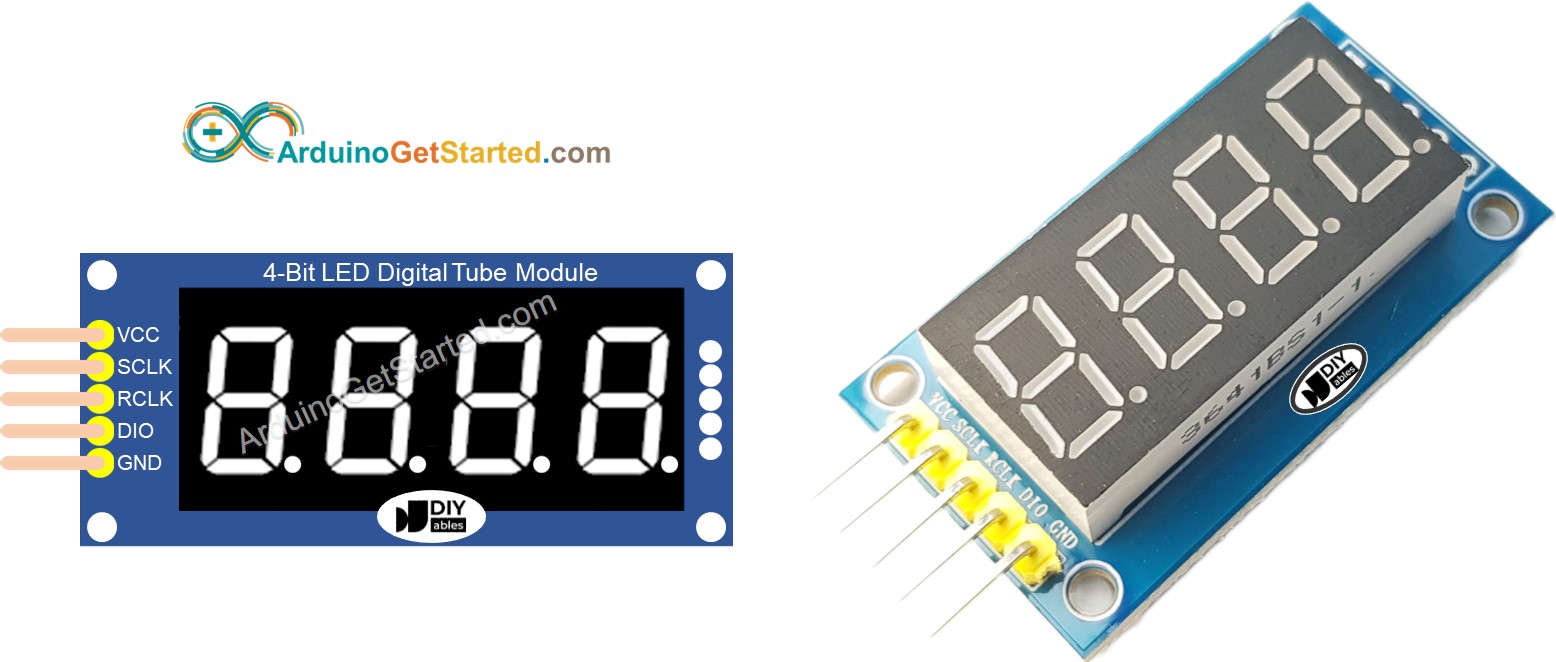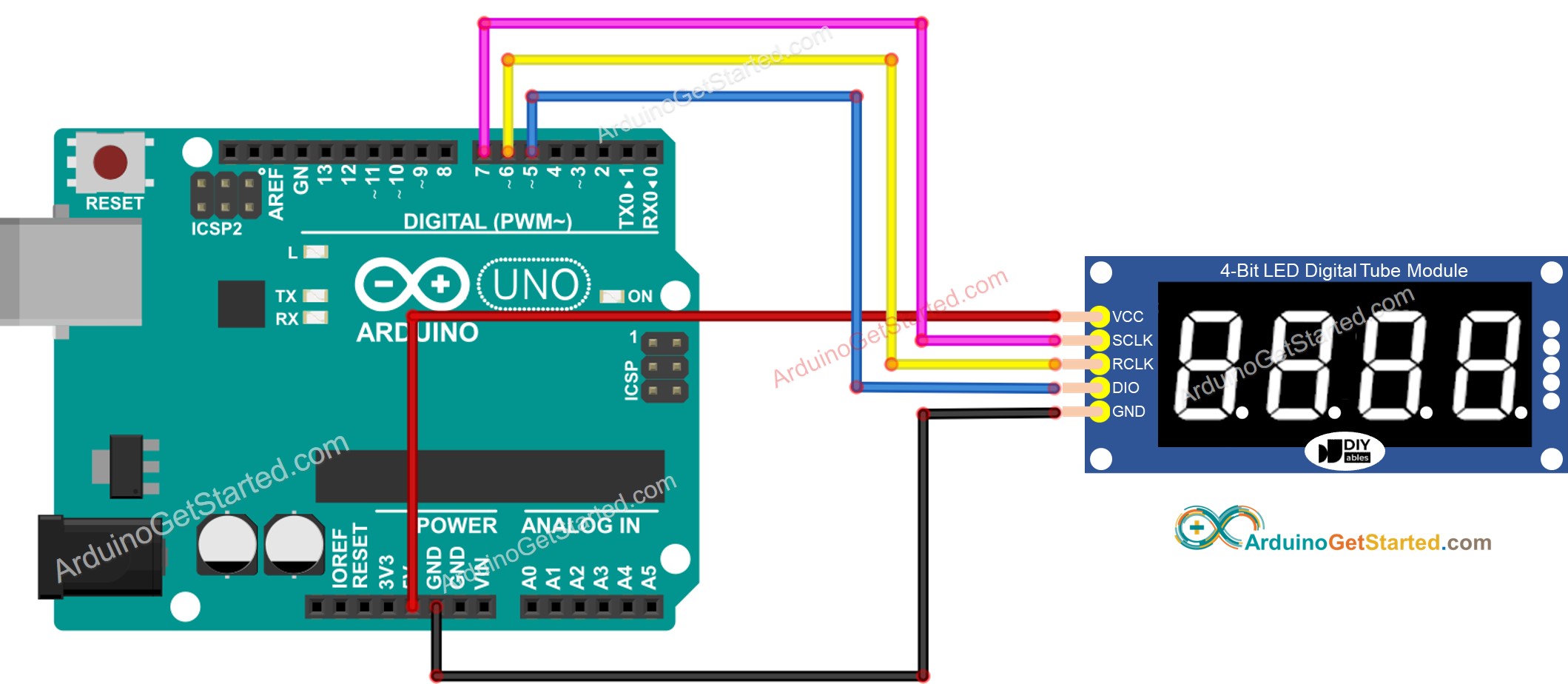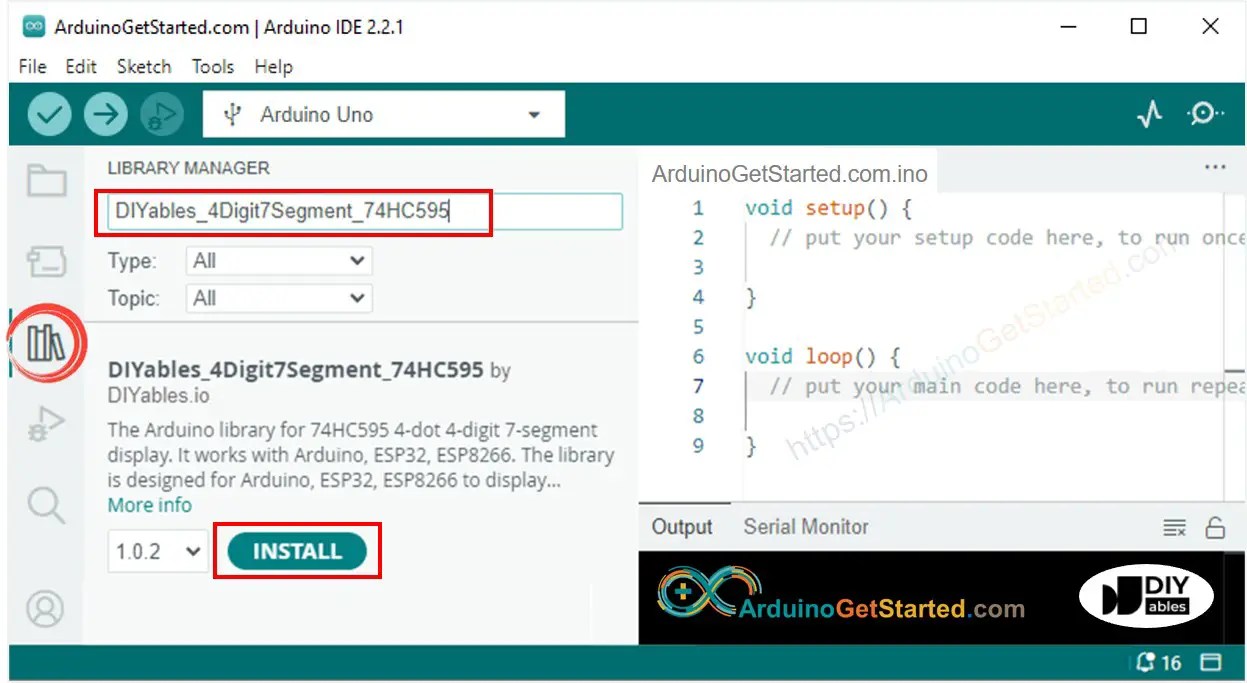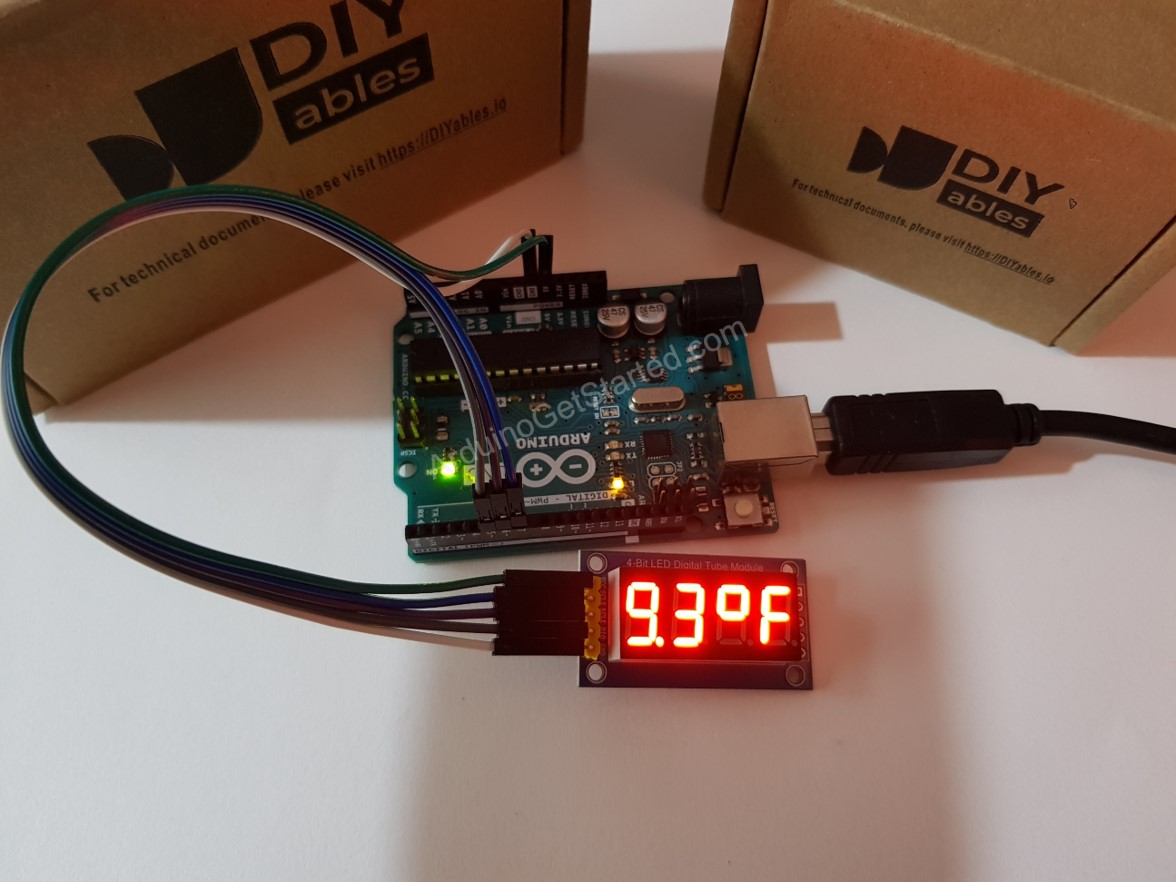A standard 4-digit 7-segment display is needed for clock, timer and counter projects, but it usually requires 12 connections. The 74HC595 module makes it easier by only requiring 5 connections: 2 for power and 3 for controlling the segments.
This tutorial will not overload you by deep driving into hardware. Instead, We will learn how to connect the 4-digit 7-segment display to Arduino, how to program it do display what we want.

This tutorial are going to use the 4-dot 4-digit 7-segment display module that is able to displayed the float values. If you want to display a colon separator, please use the TM1637 4-digit 7-segment Display Module
Hardware Required
Or you can buy the following sensor kit:
| 1 | × | DIYables Sensor Kit 30 types, 69 units |
Please note: These are Amazon affiliate links. If you buy the components through these links, We will get a commission at no extra cost to you. We appreciate it.
About 74HC595 4-digit 7-segment Display
A 74HC595 4-digit 7-segment display module typically consists of 4 7-segment LEDs, 4 dot-shaped LEDs, and a 74HC595 driver for each digit: It is ideal for displaying the temperature or any decimal value.
Pinout
The 74HC595 4-digit 7-segment display module includes 5 pins:
SCLK pin: is a clock input pin. Connect to any digital pin on Arduino.
RCLK pin: is a clock input pin. Connect to any digital pin on Arduino.
DIO pin: is a Data I/O pin. Connect to any digital pin on Arduino.
VCC pin: supplies power to the module. Connect it to the 3.3V to 5V power supply.
GND pin: is a ground pin.

Wiring Diagram
The table below shown the wiring between Arduino pins and a 74HC595 4-digit 7-segment display pins:
| Arduino | 74HC595 7-segment display |
|---|---|
| 5V | 5V |
| 7 | SCLK |
| 6 | RCLK |
| 5 | DIO |
The pin numbers in the code should be changed if different pins are used.

This image is created using Fritzing. Click to enlarge image
Library Installation
To program easily for 74HC595 4-digit 7-segment Display, we need to install DIYables_4Digit7Segment_74HC595 library by DIYables.io. Follow the below steps to install the library:
Navigate to the Libraries icon on the left bar of the Arduino IDE.
Search “DIYables_4Digit7Segment_74HC595”, then find the DIYables_4Digit7Segment_74HC595 library by DIYables.io
Click Install button.

You can also see this library on Github
How To Program For 74HC595 4-digit 7-segment using Arduino
Include the library
#include <DIYables_4Digit7Segment_74HC595.h>
Define Arduino's pins that connects to SCLK, RCLK and DIO of the display module. For example, pin D7, D6 and D5
#define SCLK 7 // The Arduino pin connected to SCLK#define RCLK 6 // The Arduino pin connected to RCLK#define DIO 5 // The Arduino pin connected to DIO
Create a display object of type DIYables_4Digit7Segment_74HC595
DIYables_4Digit7Segment_74HC595 display = DIYables_4Digit7Segment_74HC595(CLK, DIO);
Then you can display the integer numbers with the zero-padding option, supporting the negative number:
display.printInt(-13, false); // you can display a value from -999 to 9999
You can display the float numbers with the decimal place, zero-padding options, supporting the negative number:
You can also display number, decimal point, character digit-by-digit by using lower-level functions:
// display 9.3°Cdisplay.clear();display.setNumber(1, 9); // set 9 at the 1st digitdisplay.setDot(1); // set . at the 1st digitdisplay.setNumber(2, 3); // set 3 at the 2nd digitdisplay.setChar(3, SegChars::DEGREE); // set ° at the 3rd digitdisplay.setChar(4, SegChars::C); // set C at the 3rd digitdisplay.show(); // show on the display
Because the 74HC595 4-digit 7-segment module uses the multiplexing technique to control individual segments and LEDs, Arduino code MUST:
Call display.show() function in the main loop
Not use delay() function in the main loop
You can see more detail in the the library reference
Arduino Code - Display Integer
/* Created by DIYables This example code is in the public domain Product page: https://diyables.io/products/4-digit-7-segment-display-led-74hc595-driver-with-4-dots*/#include <DIYables_4Digit7Segment_74HC595.h> // DIYables_4Digit7Segment_74HC595 library#define SCLK 7 // The Arduino pin connected to SCLK#define RCLK 6 // The Arduino pin connected to RCLK#define DIO 5 // The Arduino pin connected to DIODIYables_4Digit7Segment_74HC595 display(SCLK, RCLK, DIO);void setup() { Serial.begin(9600); display.printInt(-13, false); // you can display a value from -999 to 9999 //display.printInt(-132, false); //display.printInt(9132, false); //display.printInt(132, false); //display.printInt(32, false); //display.printInt(2, false); //display.printInt(2, true);}void loop() { display.loop(); // MUST call the display.loop() function in loop() // DO SOMETHING HERE // NOTE: do NOT use the delay() function in loop because it affects to the multiplexing}
Quick Steps
Copy the above code and open with Arduino IDE
Click Upload button on Arduino IDE to upload code to Arduino
See the states of the 7-segment display
Arduino Code - Display Float
/* Created by DIYables This example code is in the public domain Product page: https://diyables.io/products/4-digit-7-segment-display-led-74hc595-driver-with-4-dots*/#include <DIYables_4Digit7Segment_74HC595.h> // DIYables_4Digit7Segment_74HC595 library#define SCLK 7 // The Arduino pin connected to SCLK#define RCLK 6 // The Arduino pin connected to RCLK#define DIO 5 // The Arduino pin connected to DIODIYables_4Digit7Segment_74HC595 display(SCLK, RCLK, DIO);void setup() { Serial.begin(9600); display.printFloat(-9.2, 1, false); //display.printFloat(-92.4, 1, false); //display.printFloat(-9.24, 2, false); //display.printFloat(192.4, 1, false); //display.printFloat(19.24, 2, false); //display.printFloat(1.924, 3, false);}void loop() { display.loop(); // MUST call the display.loop() function in loop() // DO SOMETHING HERE // NOTE: do NOT use the delay() function in loop because it affects to the multiplexing}
Arduino Code - Display Temperature
/* Created by DIYables This example code is in the public domain Product page: https://diyables.io/products/4-digit-7-segment-display-led-74hc595-driver-with-4-dots*/#include <DIYables_4Digit7Segment_74HC595.h> // DIYables_4Digit7Segment_74HC595 library#define SCLK 7 // The Arduino pin connected to SCLK#define RCLK 6 // The Arduino pin connected to RCLK#define DIO 5 // The Arduino pin connected to DIODIYables_4Digit7Segment_74HC595 display(SCLK, RCLK, DIO);void setup() { Serial.begin(9600); // display 9.3°C by controlling digit by digit display.clear(); display.setNumber(1, 9); // set 9 at the 1st digit display.setDot(1); // set . at the 1st digit display.setNumber(2, 3); // set 3 at the 2nd digit display.setChar(3, SegChars::DEGREE); // set ° at the 3rd digit display.setChar(4, SegChars::C); // set C at the 3rd digit display.show(); // show on the display}void loop() { display.loop(); // MUST call the display.loop() function in loop() // DO SOMETHING HERE // NOTE: do NOT use the delay() function in loop because it affects to the multiplexing}
The result is as the below image:

Video Tutorial
We are considering to make the video tutorials. If you think the video tutorials are essential, please subscribe to our YouTube channel to give us motivation for making the videos.
The Best Arduino Starter Kit
See the best Arduino kit for beginner
See Also
Arduino - TM1637 4-Digit 7-Segment Display
Arduino - 7-segment Clock
※ OUR MESSAGES
We are AVAILABLE for HIRE. See how to hire us to build your project
If this tutorial is useful for you, please give us motivation to make more tutorials.
You can share the link of this tutorial anywhere. Howerver, please do not copy the content to share on other websites. We took a lot of time and effort to create the content of this tutorial, please respect our work!
PREVIOUS
NEXT
DISCLOSURE
ArduinoGetStarted.com is a participant in the Amazon Services LLC Associates Program, an affiliate advertising program designed to provide a means for sites to earn advertising fees by advertising and linking to Amazon.com, Amazon.it, Amazon.fr, Amazon.co.uk, Amazon.ca, Amazon.de, Amazon.es, Amazon.nl, Amazon.pl and Amazon.se
Copyright © 2018 - 2024 ArduinoGetStarted.com. All rights reserved.
Terms and Conditions | Privacy Policy
Email: ArduinoGetStarted@gmail.com
